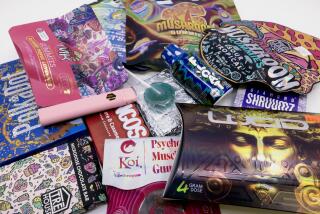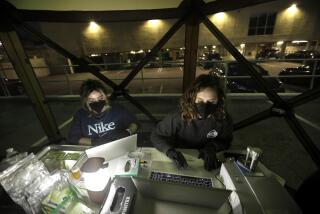Labels’ Potency Claims Often Inaccurate, Analysis Finds
The analysis of St. John’s wort commissioned by The Times examined whether retail products were as potent as they claimed to be. The analytical technique, called spectrophotometry, tested each product for a family of compounds known collectively as hypericin.
Scientists say that hypericin is not the only, and probably not even the primary, ingredient with antidepressant activity in St. John’s wort. The herb contains several other compounds that also appear to affect brain chemistry in ways that could lift mood, according to test-tube studies of nerve cells. Strictly speaking, then, a product with low hypericin levels is not necessarily an inactive one, researchers and herbalists say.
However, unusually low hypericin levels are generally accepted in the industry as a sign of poor quality. Hypericin remains the gauge of authenticity, purity and strength of St. John’s wort extracts.
For the tests, only products that specified the hypericin level were sampled. Bought in six Los Angeles-area stores in July, they were labeled as “standardized” or having “certified potency,” “high potency” or “guaranteed potency.”
Overall, seven of the 10 products contained between 75% and 135% of the labeled hypericin level, and three contained no more than about half the labeled potency, the lab found.
Cost and potency did not necessarily go together. Two of the three lowest-scoring brands cost less than the average price of 18 cents per pill. But two of the three highest-scoring brands also cost somewhat less than the average. The most expensive brand was among the highest in potency, but the second-most expensive brand was among the least potent.
Some of the variation in potency may reflect natural decay of hypericin in the product after it leaves the factory, several scientists said. For instance, one of the three packages of Kira--the brand used in most of the German clinical trials--was found to have pills with 81% of the labeled hypericin level, whereas the other two packages had 91%. Dick Middleton, technical manager of Lichtwer Pharma in Britain, said the lower-level package might have suffered in shipping and storage since leaving Berlin some months before.
Three methods exist for measuring hypericin. The U.S. Pharmacopeia plans to issue specifications for a new hypericin test this fall. The method used in the tests for The Times is a spectrophotometric test--a measurement of color in a solution--called DAC-91.
*
Officials of several companies objected to the use of that method, saying it yields results that are slightly lower than an earlier version, called DAC-86. Some of the companies still use DAC-86 to monitor their products.
The head of Jarrow Formulas, Jarrow Rogovin, for example, said the method used in The Times’ survey resulted in hypericin readings that are 20% below those found by the method the company’s extract supplier uses, “which accounts for the difference between our label claim and the results obtained.”
Officials at Enzymatic Therapy and Nature’s Resource made a similar argument.
The method used by The Times is “the accepted industry standard for testing,” said Roy Upton, an herbalist and editor of the American Herbal Pharmacopoeia. It was adopted several years ago by the German government for St. John’s wort testing, though methods continue to evolve.
Just how closely herbal supplements should adhere to their labeled potency is a matter of some debate. FDA regulations state that the concentration of labeled ingredients in dietary supplements, including herbal medications, must equal 100% of the amount claimed on the package throughout the product’s shelf life.
In reality, though, holding herbal products to that standard can be difficult because the chemical composition of a plant varies from crop to crop, and analytical techniques for measuring key compounds can yield somewhat different results, an FDA official said.
So some experts argue that herbal products containing 80% to 120% of the labeled potency are close enough. “That might be reasonable,” said Sally Guthrie, a University of Michigan clinical pharmacist.
Others narrow the margin to 90% to 110%. “At this point, 90% of label claim is what I would specify” as a minimum, said V. Srini Srinivasan, a senior scientist at the U.S. Pharmacopeia.
But Mark Blumenthal, director of the American Botanical Council, an independent scientific and policy group, disagrees, arguing that a product really should have 100% of what its label claims.
“If they say they have 0.3% hypericin at 300 milligrams, they should have that,” he said. “As a consumer, I want to know that I’m getting what I pay for.”
(BEGIN TEXT OF INFOBOX / INFOGRAPHIC)
Testing St. John’s Wort
In a spot check of retail St. John’s wort supplements, the potency varied, according to an independent laboratory test commissioned by The Times. The potency depends on the milligrams of the compound hypericin in each capsule or tablet.
*--*
Claimed Tested Potency Potency % of Costs Brand Name mg./pill mg./pill Label Claim cents/pill Enzymatic Therapy 0.90 0.71 78.9 22 Futurebiotics 1.05 0.53 50.5 25 Jarrow Formulas 0.90 0.69 76.7 17 Kira 0.90 0.79 87.8 30 Nature’s Herbs 0.35 0.46 131.4 17 Nature’s Resource 0.30 0.42 140.0 15 Pure Source 0.90 0.20 22.2 12 Safeway Select 0.90 0.81 90.0 20 Sundown Herbals 0.45 0.09 20.0 11 Trader Joe’s 0.90 0.74 82.2 9
*--*
The tested potency represents the average of three samples. The margin of error is approximately +/- 5%. The testing, using a spectrophotometric method known officially as DAC-91, was done by Flora Research, an analytical firm in San Juan Capistrano.






